Spirits Arise
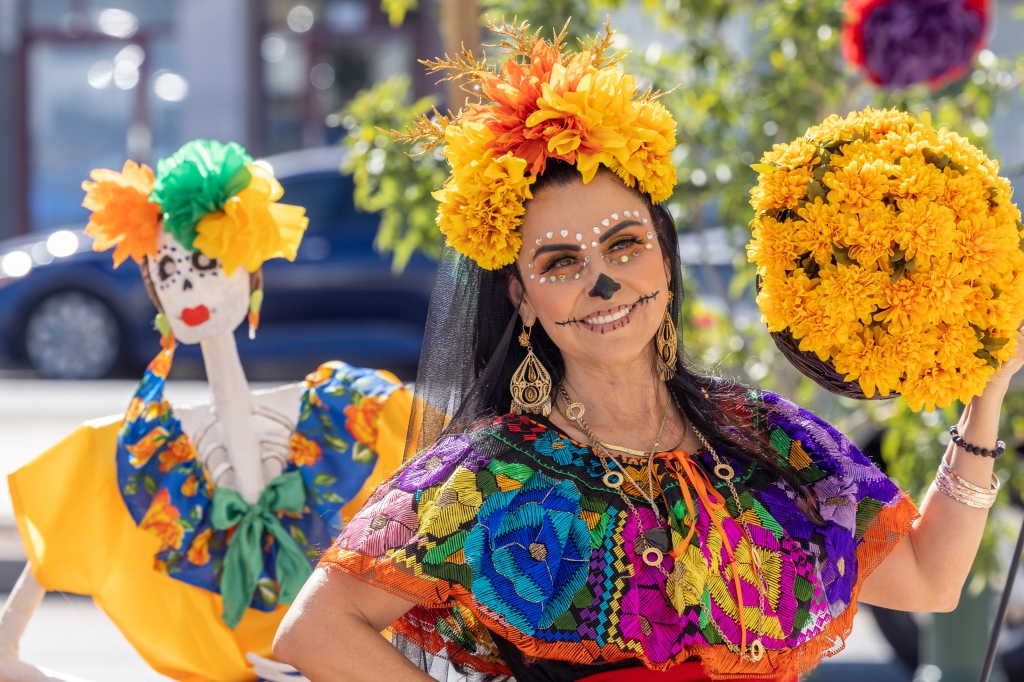
Arizona’s Vibrant Día de los Muertos Celebrations
Writer Joseph J. Airdo
As October’s crisp air settles over Arizona, a vibrant undercurrent of excitement begins to pulse through the state. It’s not just the approach of Halloween that has residents buzzing, but the anticipation of Día de los Muertos — the Day of the Dead.
This cherished Mexican holiday, a poignant blend of pre-Columbian traditions and Catholic influences, has found a second home in the Southwest, where it has evolved into a kaleidoscope of unique celebrations that honor the departed while embracing the vitality of life.
From the streets of Tucson to the gardens of Phoenix, and from the red rocks of Sedona to the high country of Prescott Valley, Arizona offers a rich tapestry of Día de los Muertos events. Each celebration paints its own portrait of remembrance and joy, inviting both the culturally curious and those seeking to honor loved ones to partake in the festivities.
This month, Images Arizona embarks on a journey through seven of our state’s most captivating Día de los Muertos celebrations, where marigolds bloom, sugar skulls grin, and the veil between worlds grows thin. So grab your camera, don your finest Catrina makeup and prepare to dance with the memories of those who’ve passed on – for in Arizona, the dead come alive in a spectacular celebration of life, love and legacy.
Día de los Muertos Festival (Mesa)
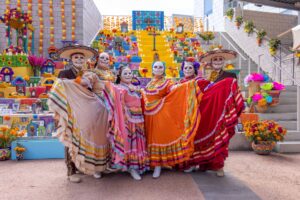


Mesa’s Día de los Muertos Festival, now in its 19th year, offers a vibrant celebration of life and remembrance at the Mesa Arts Center. This free, two-day event on Oct. 19 and 20, has earned national recognition for its authentic representation of the holiday.
Mandy Tripoli, deputy director of visual arts and engagement/education for Mesa Arts Center, shares what makes their festival special: “From the community altar that invites attendees to add photographs to honor the memories of their loved ones to diverse performances and hands-on art activities, we celebrate the richness of Mexican culture.”
Visitors can enjoy nonstop entertainment, including mariachi music and folkloric dance, while exploring a bustling Mercado Marketplace. New additions this year include an expanded food court with roaming elote carts and a dedicated DJ stage.
A unique feature is the Relaxed Hour on Sunday morning, providing a sensory-friendly experience for those with additional needs.
“The excitement, support and participation from our guests are what infuse this festival with its vibrant spirit,” Tripoli adds.
Día de los Muertos Fiestas (Scottsdale)
Scottsdale’s Día de los Muertos celebration offers a multifaceted experience spanning 10 days from Oct. 24 to Nov. 2. The event series, newly designated as a city of Scottsdale signature event, provides a comprehensive immersion into the holiday’s traditions.
Helen Gandara, co-chair and founder of Scottsdale Día de Los Muertos, emphasizes the city’s commitment: “The city of Scottsdale is proud to carry on the traditions of the important cultures that helped shape this community, and Día de los Muertos is just one such example.”
The celebration includes an Altares y Ofrendas Experience at the Old Adobe Mission, large-scale art installations at the Scottsdale Civic Center, and a traditional Desfile de Muertos procession. The highlight is the Fiesta de Muertos Festival on Oct. 26, featuring performances, food vendors and crafts.
Robert Ramirez, executive producer and founder, adds, “Our Día de los Muertos festivities provide attendees many uniquely curated kindred experiences to learn, celebrate and honor the sacred memories of our loved ones.”
Mikiztli: Día de los Muertos Festival (Phoenix)
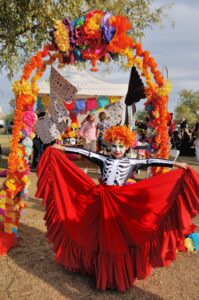


In the sprawling metropolis of Phoenix, Cultural Coalition, Inc. presents Mikiztli, a celebration that harkens back to the holiday’s indigenous roots. Held at Steele Indian School Park on Oct. 27, this free event is the largest Día de los Muertos festival in Phoenix.
Zarco Guerrero, board president of the Cultural Coalition, explains the festival’s name: “Although its literal translation is ‘death,’ its true meaning is ‘transcendence.’ The festival is symbolized by the calaca, or smiling skull, which entices and invites us to dance.”
Mikiztli sets itself apart by focusing on pre-Columbian traditions and offering a wide array of participatory arts activities. Visitors can contribute to the community altar, participate in mask-making workshops, and witness the burning of “peñas” — written prayers or messages to the departed.
As the sun sets, a procession of artists, giant puppets and festivalgoers winds its way through the park, culminating in a joyous dance party that celebrates both life and the memories of loved ones.
Día de los Muertos at Tlaquepaque (Sedona)
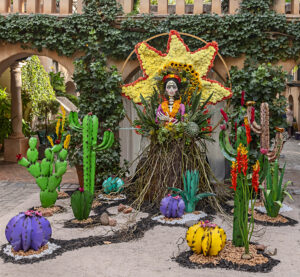


Against the backdrop of Sedona’s red rocks, Tlaquepaque Arts & Shopping Village hosts a captivating Día de los Muertos celebration on Nov. 1 and 2. This free two-day event transforms the village’s streets, patios and fountains into a vibrant tapestry of remembrance.
Wendy Lippman, general manager and resident partner of Tlaquepaque, highlights what makes their event unique: “We incorporate new themes and concepts every year, encouraging visitors to explore each area as they represent different aspects of the celebration, from ancient Aztec traditions to modern interpretations like Barbie.”
Visitors can admire exquisitely curated altars, participate in the Marigold Mural Project, and enjoy performances by Ballet de Colores Folklorico and Urban Electra. The celebration also features a mercado, offering a chance to shop and dine amid the festivities.
Día de los Muertos Celebration (Prescott Valley)
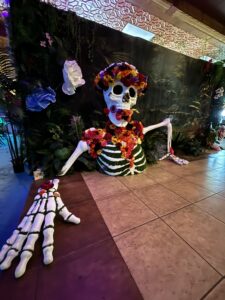


Prescott Valley joins the Día de los Muertos celebration scene with its inaugural event on Nov. 2. This celebration, put on by Fain Signature Group in collaboration with the Hispanic Business Association, brings the rich traditions of the holiday to the high country.
Brad Fain, president and CEO of Fain Signature Group, expresses their mission: “We are excited to offer awareness and educational opportunities about Día de los Muertos and other culturally significant events, enriching the lives of families, children, and individuals in our community.”
The celebration features an immersive 12,000-square-foot installation by Haus of Themes, complete with giant calaveras and interactive AR elements. Visitors can enjoy food trucks offering Mexican cuisine, participate in an Ofrenda contest, and witness performances by folklórico dancers and Mariachi Continental Azteca.
La Procesión (Phoenix)
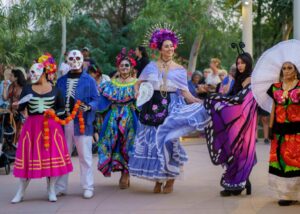


Amid the iconic saguaros and desert flora, the Desert Botanical Garden’s Día de los Muertos celebration offers a unique blend of nature and tradition. This two-day festival on Nov. 2 and 3 transforms the garden into a living canvas of remembrance.
Laura Best, senior director of exhibits, and Amber Salazar, assistant director of event services, describe the event’s magic: “The excitement, support and participation from our guests are truly what make this festival so magical. Guests of all ages come dressed up, get their faces painted and are ready for a day of honoring and celebrating our past loved ones.”
This year’s celebration introduces new elements focusing on the legend of the cempasúchil flower (marigold) and the hummingbird, highlighting their connection to Día de los Muertos. Visitors can marvel at monumental cempasúchil flowers crafted by artisans in Oaxaca and handcrafted hummingbirds from silversmiths in Taxco.
The festival culminates in La Procesión, a garden-wide procession featuring colorful alebrijes (fantastical creatures) and the symbolic burning of worries and sorrows.
All Souls Procession (Tucson)
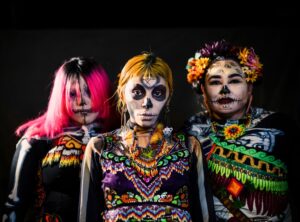


In the heart of the Old Pueblo, the All Souls Procession stands as a testament to the power of community and creativity. What began in 1990 as artist Susan Johnson’s personal tribute to her late father has blossomed into one of North America’s largest celebrations to honor the dead and celebrate life, drawing upward of 200,000 participants over several days.
The weekend’s events unfold from Nov. 1–3, culminating in the grand procession on Sunday evening. As dusk falls on Nov. 3, downtown Tucson transforms into a river of remembrance. The 2-mile procession concludes with the burning of a giant urn filled with the hopes and wishes of participants for their departed loved ones.
The weekend also features the Procession of Little Angels for families on Saturday and the Dance of the Dead concerts on Friday and Saturday nights, ensuring there’s something for everyone throughout the celebration.
Nadia Hagen, artistic director of Many Mouths One Stomach, the nonprofit behind the event, describes it as a “massive outpouring of respect and tears, generosity and creativity.” She emphasizes its inclusive nature: “All Souls is truly meant for all souls. We are honored to provide a space where any funerary tradition can be represented, as chosen by the public.”
As the All Souls Procession winds through the streets of Tucson, it serves as a fitting finale to Arizona’s nearly monthlong celebration of Día de los Muertos. From Mesa’s family-friendly festivities to Prescott Valley’s inaugural event, and from Sedona’s artistic displays to Phoenix’s garden-based homage, each celebration offers a unique window into this rich tradition.
The procession, with its elaborate costumes, towering puppets and mesmerizing performances, embodies the spirit of all these events — a collective remembrance, a celebration of life and a bridge between cultures.
